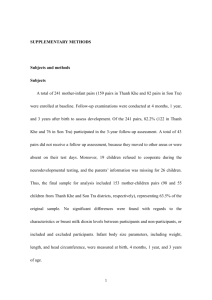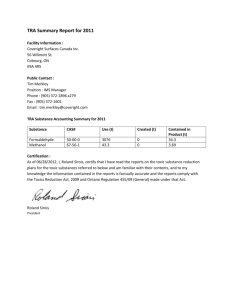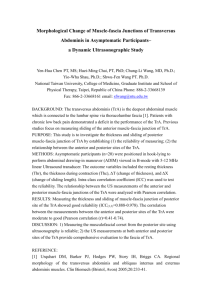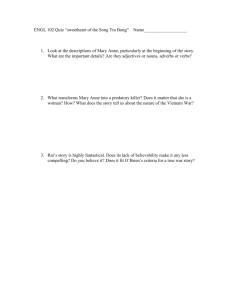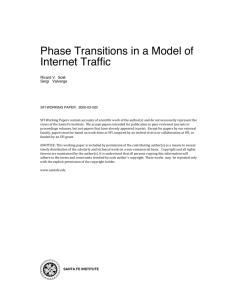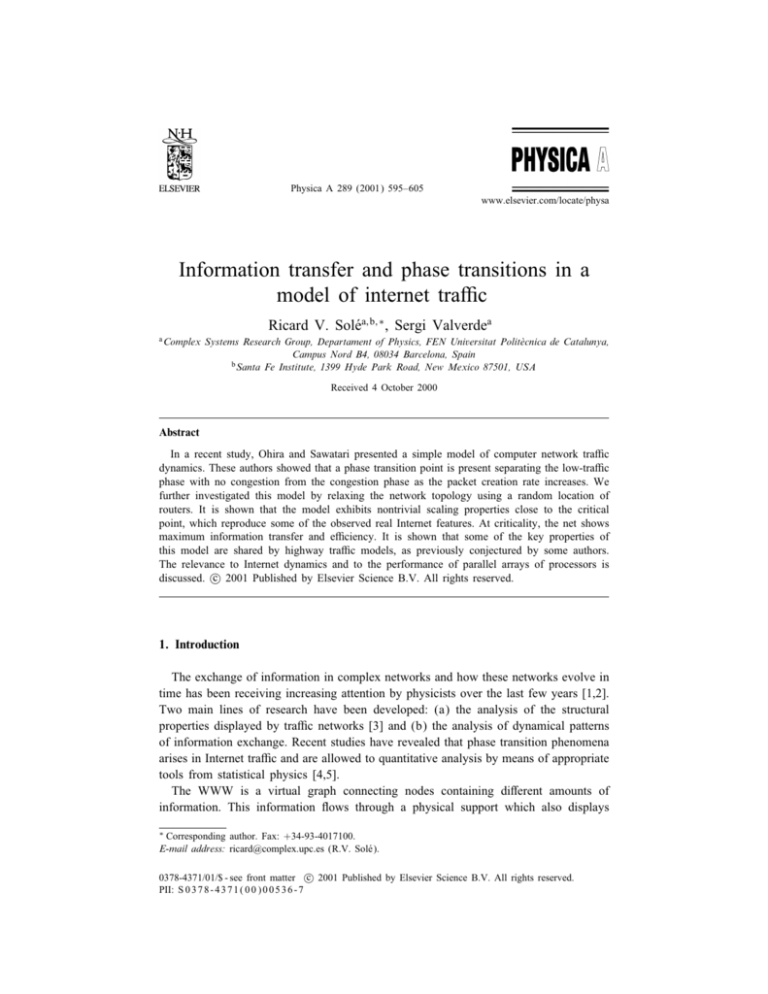
Physica A 289 (2001) 595–605
www.elsevier.com/locate/physa
Information transfer and phase transitions in a
model of internet trac
a Complex
Ricard V. Solea; b; ∗ , Sergi Valverdea
Systems Research Group, Departament of Physics, FEN Universitat PolitÂecnica de Catalunya,
Campus Nord B4, 08034 Barcelona, Spain
b Santa Fe Institute, 1399 Hyde Park Road, New Mexico 87501, USA
Received 4 October 2000
Abstract
In a recent study, Ohira and Sawatari presented a simple model of computer network trac
dynamics. These authors showed that a phase transition point is present separating the low-trac
phase with no congestion from the congestion phase as the packet creation rate increases. We
further investigated this model by relaxing the network topology using a random location of
routers. It is shown that the model exhibits nontrivial scaling properties close to the critical
point, which reproduce some of the observed real Internet features. At criticality, the net shows
maximum information transfer and eciency. It is shown that some of the key properties of
this model are shared by highway trac models, as previously conjectured by some authors.
The relevance to Internet dynamics and to the performance of parallel arrays of processors is
c 2001 Published by Elsevier Science B.V. All rights reserved.
discussed. 1. Introduction
The exchange of information in complex networks and how these networks evolve in
time has been receiving increasing attention by physicists over the last few years [1,2].
Two main lines of research have been developed: (a) the analysis of the structural
properties displayed by trac networks [3] and (b) the analysis of dynamical patterns
of information exchange. Recent studies have revealed that phase transition phenomena
arises in Internet trac and are allowed to quantitative analysis by means of appropriate
tools from statistical physics [4,5].
The WWW is a virtual graph connecting nodes containing dierent amounts of
information. This information ows through a physical support which also displays
∗ Corresponding author. Fax: +34-93-4017100.
E-mail address: ricard@complex.upc.es (R.V. Sole).
c 2001 Published by Elsevier Science B.V. All rights reserved.
0378-4371/01/$ - see front matter PII: S 0 3 7 8 - 4 3 7 1 ( 0 0 ) 0 0 5 3 6 - 7
596
R.V. SolÃe, S. Valverde / Physica A 289 (2001) 595–605
scale-free behavior [3]. The network of computers is itself a complex system, and
complex dynamics has been detected suggesting that self-similar patterns are also at
work [6].
Some previous studies have shown evidence for critical-like dynamics in Computer
Networks [7] in terms of fractal, 1=f noise spectrum as well as long-tail distributions
of some characteristic quantities. Some authors have even speculated about the possibility that the trac of information through computer networks (such as Internet)
can display the critical features already reported in cellular automata models of trac
ow, such as the Nagel–Schreckenberg (NS) model [8–10]. The NS model shows that
as one increases the density of cars , a well-dened transition occurs at a critical
density c . This transition separates a uid phase showing no jams from the jammed
phase were trac jams emerge. At the critical boundary, the rst jams are observed
as back-propagating waves with fractal properties.
A number of both quantitative and qualitative observations of real computer network
dynamics reveals some features of interest:
1. Extensive data mining from Internet=Ethernet trac shows that it displays long-range
correlations [6] with well-dened persistence, as measured by means of the Hurst exponent. This analysis totally rejects the previous theoretical approach to Poisson-based
(Markovian) models assuming statistical independence of the arrival process of information.
2. Fluctuations in density of packets show well-dened self-similar behavior over long
time scales. This has been measured by several authors [7,11]. The power spectrum
is typically a power law, although local (spatial) dierences have been shown to be
involved.
3. The statistical properties of Internet congestion reveal long-tailed (lognormal) distributions of latencies. Here latency times TL are thus given by
ln T
1
√ exp − 2L :
P(TL ) =
2
TL 2
Latencies are measured by performing series of experiments in which the round-trip
times of ping packets is averaged over many sent messages between two given
nodes.
4. There is a clear feedback between the bottom-level where users send their messages
through the net and increase network activity (and congestion) and the top-level described by the overall network activity. Users are responsible for the global behavior
(since packets are generated by users) and the later modies the individual decisions
(users will tend to leave the net if it becomes too congested).
On the other hand, previous studies on highway trac dynamics revealed that the
phase transition point presented by the models as the density of cars increased was
linked with a high degree of unpredictability [12]. Interestingly, this is maximum at
criticality [13] as well as the ow rate. In other words, eciency and unpredictability
are connected by the phase transition. In this paper, the previous conjecture linking
R.V. SolÃe, S. Valverde / Physica A 289 (2001) 595–605
597
Internet dynamics with critical points in highway trac is further explored. By considering a generalization of the Ohira–Sawatari (OS) model, we show that all the
previously reported features of real trac dynamics are recovered by the model. The
paper is organized as follows. In Section 2, the basic model and its phase transition
is presented. In Section 3 the self-similar character of the time dynamics is shown
by means of the calculation of the latency times and queue distributions as well as
by means of spectral and Hurst analysis. In Section 4, the eciency and information
transfer are calculated for dierent network sizes. In Section 5 our main conclusions
and a discussion of its implications is presented.
2. Model of computer network trac
Following the work by Ohira and Sawatari, let us consider a two-dimensional network with a square lattice topology with four nearest neighbors [14]. The network
involved two types of nodes: hosts and routers. The rst are nodes that can generate and receive messages and the second can only store and forward messages. Our
square, L × L lattice will be indicated as L(L), following previous notation [15]. All
our simulations are performed using periodic boundary conditions. In previous papers,
either the hosts were distributed through the boundary [14] (and thus the inner nodes
were routers) or all nodes were both hosts and routers [15]. Here we consider a more
realistic situation, where only a fraction of the nodes are hosts and the rest are
routers [14] (Fig. 1).
The location of each object, r ∈ L(L), will be given by r = icx + jcy , where cx ; cy
are Cartesian unit vectors. So the set of nearest neighbors C(r) is given by
C(r) = {r − cx ; r + cx ; r − cy ; r + cy } :
(1)
Each node maintains a queue of unlimited length where the packets arriving are
stored. The local number of packets will be indicated as n(r; t) and thus the total
number of packets in the system will be
X
n(r; t) :
(2)
N (t) =
r∈L(L)
The rules are dened as in the OS deterministic model (the stochastic version only
shows the dierences already reported by these authors [14]). The rules are dened as
follows:
• Creation: The hosts create packets following a random uniform distribution with
probability . Only another host can be the destination of a packet, which is also
selected randomly. Finally, this new packet is appended at the end of the host tail.
• Routing: Each node picks up the packet at the head of its queue and decides which
outgoing link is better suited to the packet destination. Here, the objective is to
minimize the communication time for any single message, taking into account only
shortest paths and also avoiding congested links. First, the selected link is the one
that points to a neighbour node that is nearer to the packet destination. Second,
598
R.V. SolÃe, S. Valverde / Physica A 289 (2001) 595–605
Fig. 1. Model network architecture (two-dimensional lattice, periodic boundary conditions). Two types of
nodes are considered: hosts (gray squares) which can generate and receive messages, and routers (open
circles) which can store and forward messages.
when two choices are possible, the less congested link is selected. The measure of
congestion of a link is simply dened as the amount of packets forwarded through
that link. Once the node has made the routing decision, the packet is inserted at
the end of the queue of the node selected and the counter of the outgoing link is
incremented by one.
These rules are applied to each site and each L ×L updatings dene our time step.
This model exhibits a similar phase transition than the one reported in previous
studies [14,15]. It is shown in Fig. 2 for a L = 32 system with = 0:08 (the same
density is used in all our simulations). We can see that the transition occurs at a given
c ≈ 0:2. As it occurs with models of highway trac, the ow of packets is maximized
at criticality, as shown in Fig. 2B, where the number of delivered packets (indicated
as NDP) is plotted.
3. Scaling and self-similarity
An example of the time series at criticality for the previous system is shown in
Figs. 3Aand B. It conrms our expectations and previous observation from real computer trac: the local uctuations in the number of packets n(r; t) are self-ane, as
we can appreciate from an enlargement of the rst plot. This is conrmed by the
R.V. SolÃe, S. Valverde / Physica A 289 (2001) 595–605
599
Fig. 2. (A) Phase transition in network trac. Here L = 32 lattice has been used and the average latency
has been computed over dierent, increasing intervals of time T steps, as indicated. The density of hosts is
= 0:08. (B) As a measure of eciency, the number of delivered packets Ndp has been measured under
the same conditions. We can see the optimum at the critical point c ≈ 0:2. For ¡ c we have a linear
increase Ndp = with = L2 T , corresponding to the number of released packets.
calculation of the power spectrum P(f). It is shown in Fig. 4 and scales as
P(f) ≈ f−
( = 0:97 ± 0:06) :
(3)
There is some local variability in the value of the scaling exponent through space,
but it is typically inside the interval −0:75 ¡ ¡ 1:0, in agreement with data analysis
[7,11].
The statistics of latencies and queue lengths leads to long tails close to criticality.
Some examples of the results obtained are shown in Fig. 5. Here a L = 256 lattice
has been used. Latencies are measured as the number of steps needed to travel from
emitting hosts to their destinations. The distribution of latencies close to c is a log
normal, in agreement with the study of Huberman and Adamic for round-trip times of
ping packets [12]. This means that there is a characteristic latency time but also very
600
R.V. SolÃe, S. Valverde / Physica A 289 (2001) 595–605
Fig. 3. An example of the time-series dynamics of the number of packets n(r; t) at a given arbitrary node.
Here L = 256; = 0:08 and = c = 0:055. We can see in (A) uctuations of many sizes, which display
self-anity, as we can see from (B) where the fraction of the previous time series indicated by means of a
window has been enlarged.
Fig. 4. Power spectrum P(f) computed from the time series shown in Fig. 3A. A well-dened scaling is at
work over four decades, with ≈ 1.
R.V. SolÃe, S. Valverde / Physica A 289 (2001) 595–605
601
Fig. 5. (A) Log-normal distribution of latency times at criticality for a L = 256 system. Here c ≈ 0:055.
Inset: three examples of these distributions in log–log scale for three dierent values (as indicated);
(B) Distributions of queue lengths for the same system at dierent rates. Scaling is observable at intermediate values close to criticality.
long tails: a high uctuation regime is present. As goes into the congestion phase,
longer times are present but also long tails. This is due to the fact that at this phase
the number of packets is always increasing with time.
The distribution of queue lengths is equivalent to the distribution of jam sizes in
the highway trac model. As with the Nagel–Schreckenberg model, the distribution
approaches a power law for ≈ c but it also displays some bending at small values
(and a characteristic cuto at large values). This is probably the result of the presence
of spatial structures, which propagate as waves of congestion and will be analyzed
elsewhere (Valverde and Sole, in preparation).
4. Eciency, uncertainty and information transfer
As mentioned in the introduction, models of highway trac ow revealed that the
ow of cars (and thus the system’s eciency) is maximal at the critical point, but that
the unpredictability is also maximal.
602
R.V. SolÃe, S. Valverde / Physica A 289 (2001) 595–605
Fig. 6. Information transfer for three dierent lattice sizes (as indicated). Information transfer grows rapidly
close to criticality but reaches a maximum at some point ∗ close to c .
Eciency can be measured in several ways. One is close to our model properties:
eciency is directly linked to information transfer and thus information-based measures
can be used. Here we consider an information-based characterization of the dierent
phases by means of the Markov partition . Specically the following binary choice
is performed:
= {n(r) = 0 ⇒ S(r) = 0; n(r) ¿ 0 ⇒ S(r) = 1}
which essentially separates non-jammed from jammed nodes.
Information transfer is maximized close to second-order phase transitions [16,17] and
should be maximum at c . In order to compute this quantity we will make use of the
previous partition . Let S(r) and S(k) the binary states associated with two given
hosts in L. The -entropy for each host is given by
X
P(S(r)) log P(S(r))
(4)
H (r) = −
S(r)=0;1
and the joint entropy for each pair of hosts,
X
P(r; k) log P(r; k) ;
H (r; k) = −
(5)
S(r); S(k)=0;1
where for simplicity we use P(r; k) ≡ P(S(r); S(k)) to indicate the joint probability.
From the previous quantities, we can compute the information transfer between two
given hosts (Fig. 6). It will be given by
M (r; k) = H (r) + H (k) − H (r; k) :
(6)
The average information transfer will be computed from M q = hM (r; k)i where the
brackets indicate average over a sample of q hosts randomly chosen from the whole
set (here q = 100).
R.V. SolÃe, S. Valverde / Physica A 289 (2001) 595–605
603
Fig. 7. The variance plot for the L = 32 system. The critical point c is perfectly indicated by this measure
with a sharp maximum. Three dierent times have been used in the averages.
At the sub-critical domain, in terms of information transfer under the Markov partition, all pairs of nodes will be typically in the non-congested (free state) and P(i; j) ≈
00 so it is easy to see that in this phase we have vanishing entropies and the mutual
information is small. The information is totally dened by the entropy of the single
nodes, as far as the correlations are trivial. A similar situation holds at the congestion
phase, where nodes are typically congested. At intermediate values, the uctuations
inherent to the system lead to a diversity of states that gives a maximum information
transfer at some c∗ . It should be noted however that this measure is not very good for
small systems, where c∗ ¿ c , but we can see that c∗ → c as L increases.
Unpredictability will be measured, following Nagel and Rasmussen [13] by means
of the normalized variance of latencies:
(TL ) =
[(TL − hTL i)2 ]1=2
;
hTL i
(7)
where hTL i is the average over a given number of steps.
The unpredictable nature of the critical point is sharply revealed by the plot of the
variance (TL ) (Fig. 7). We can see that, as it was shown by Nagel and co-workers
for highway trac, the system shows the highest unpredictability close to the critical
point. At the subcritical regime ¡ c , the packets reach their destinations in a time
close to the characteristic, average time of traveling. This situation sharply changes
in the neighborhood of c where the uctuations (experienced as local congestion)
lead to a rapid increase in the variance. As grows beyond the transition, these
uctuations are damped and (TL ) decays slowly. This result also conrms the study
by Nagel and co-workers who analyzed the behavior of the variance of travel times
[13] for a closed-loop system. They found that there was a nontrivial implication for
this result: increasing eciency (i.e., trac ow) tunes the system to criticality and as
a consequence to unpredictable behavior.
604
R.V. SolÃe, S. Valverde / Physica A 289 (2001) 595–605
5. Discussion
In this paper we have analyzed the statistical properties of a computer network
trac model. This model is a simple extension of the OS system, but with a random
distribution of hosts scattered through L with a density . One of the goals of our
study was to see if the reported regularities from real networks of computers (such as
the Internet) were similar to those observed in highway trac and reproducible by our
model. The second was to explore the possibility that the observed features correspond
to those expected from a near-to-critical system. We have presented evidence that real
Internet trac takes place close to a phase transition point, although further work is
needed involving the scale-free network topology of the real web. However, our result
provide a preliminary support to the presence of critical phenomena in parallel arrays
of computers.
The model has been shown to match some basic properties of Internet dynamics: (i)
it shows self-ane patterns of activity close to criticality, consistent with the fractal
nature of computer trac; (ii) the observed time series display 1=f behavior and
the corresponding Hurst exponents reveal the presence of persistence and long-range
correlations in congestion dynamics, as reported from real data; (iii) the distribution of
latency times close to the transition point is a lognormal, and the distribution of queue
lengths approaches power laws with some bending for small lengths (as in highway
trac models).
The model conrms the previous conjecture [7] suggesting some deep links between
the NS model and the dynamics displayed by computer networks close to critical points.
In this sense, the previous measures and other quantitative characterizations support the
idea that the two type of trac share some generic features. The model also exhibits
the same kind of variance plot shown by the NS and related models: it is almost zero at
the subcritical (free) regime and it abruptly grows close to c . This leads to the same
conclusion pointed by Nagel and co-workers: maximum eciency leads to complex
dynamics and unpredictable behavior.
Some authors have discussed the origins of Internet congestion in terms of the interactions among users [12]. Huberman and Luckose suggested that this is a particularly
interesting illustration of a social dilemma. Our study suggests a somewhat complementary view: there is a feedback between the system’s activity and the user’s behavior.
Users introduce new packets into the system, thus enhancing the congestion of the
net. As congestion increases, users tend to leave the net, thus reducing local activity.
This type of feedback is similar to the dynamics characteristic of self-organized critical
systems (such as sandpiles) [18]. The main dierence arises from the driving. Activity
is being introduced into the system without a complete temporal separation between
two scales. In this sense, this is not a self-organized critical system but it is close
enough to be the appropriate theoretical framework. An immediate extension of this
model should contain a self-tuning of : users might increase their levels of activity if
congestion is low and decrease it (or leave the system) in a very congested situation.
In this way, the system might self-organize into the critical state.
R.V. SolÃe, S. Valverde / Physica A 289 (2001) 595–605
605
Our previous results can also be applied to other, similar networks. This is the case
of large, parallel arrays of processors. In this sense, some previous studies [19] have
shown the validity of the OS model in describing the overall dynamics of small arrays
of processors with simple topologies. They also found some additional phenomena such
as the presence of hot spots, which we have also observed in our model. This work can
be extended to high-dimensional parallel systems such as the connection machine [20]
in order to test the presence of phase transitions and their dependence on dimensionality
(in particular they will help to determine the upper critical dimension for this system).
Internet dynamics and the WWW growth provide an extremely interesting, real evolution experiment of a complex adaptive system [12]. In the near future, we are likely
to see new types of behavior in the web. As Daniel Hillis predicts, as the information
available on the Internet becomes richer, and the types of interactions among computers become more complex, we should expect to see new emergent phenomena going
beyond any that has been explicitly programmed into the system [21]. Models based
on phase transitions in far from equilibrium systems will be of great help in providing
an appropriate theoretical framework.
Acknowledgements
We thank B. Luque for many useful discussions and his earlier participation in
this work. This work has been supported by a grant PB97-0693 and by the Santa Fe
Institute (RVS).
References
[1]
[2]
[3]
[4]
[5]
[6]
[7]
[8]
[9]
[10]
[11]
[12]
[13]
[14]
[15]
[16]
[17]
[18]
[19]
[20]
[21]
B. Huberman (Ed.), The Ecology of Computation, North-Holland, Amsterdam, 1989.
J.O. Kepart, T. Hogg, B. Huberman, Phys. Rev. A 40 (1989) 404.
R. Albert, H. Jeong, A.-L. Barabasi, Nature 406 (2000) 378.
M. Takayasu, K. Fukuda, H. Takayasu, Physica A 274 (1999) 140.
M. Takayasu, H. Takayasu, K. Fukuda, Physica A 277 (2000) 248.
W.E. Leland, M.S. Taqqu, W. Willinger, IEEE Trans. Networking 2 (1994) 1.
I. Csabai, J. Phys. A: Math. Gen. 27 (1994) L417.
K. Nagel, M. Schreckenberg, J. Phys. I France 2 (1992) 2221.
K. Nagel, M. Schreckenberg, J. Phys. A 26 (1993) L679.
K. Nagel, M. Paczuski, Phys. Rev. E 51 (1995) 2909.
M. Takayasu, H. Takayasu, T. Sato, Physica A 233 (1996) 824.
B.A. Huberman, R.M. Luckose, Science 277 (1997) 535.
K. Nagel, S. Rasmussen, in: R.A. Brooks, P. Maes (Eds.), Articial Life IV, MIT Press, Cambridge,
MA, 1994, p. 222.
T. Ohira, R. Sawatari, Phys. Rev. E 58 (1998) 193.
H. Fucks, A.T. Lawniczak, preprint adap-org=9909006.
R.V. Sole, S.C. Manrubia, B. Luque, J. Delgado, J. Bascompte, Complexity 1(4) 1996.
R.V. Sole, O. Miramontes, Physica D 80 (1995) 171.
P. Bak, C. Tang, K. Wiesenfeld, Phys. Rev. Lett. 59 (1987) 381.
K. Bolding, M.L. Fulgham, L. Snyden, Technical Report CSE-94-02-04.
W.D. Hillis, The Connection Machine, MIT Press, Cambridge, MA, 1985.
W.D. Hillis, The Pattern on the Stone, Weidenfeld and Nicolson, London, 1998.

